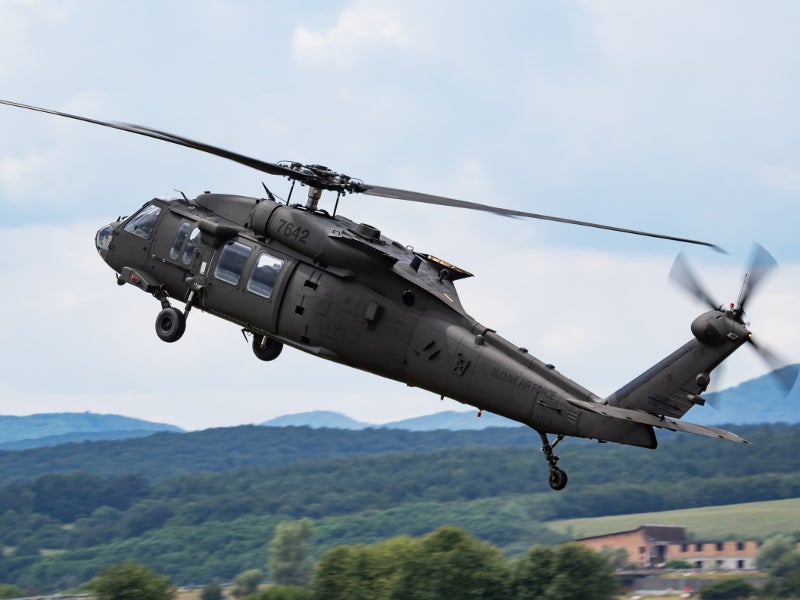Trip Ready: Making Certain Optimal Condition for Your UH 60 Helicopter
Trip Ready: Making Certain Optimal Condition for Your UH 60 Helicopter
Blog Article
Comprehending the Mechanics and Design Behind Uh 60 Helicopters
The UH-60 helicopter, typically understood as the Black Hawk, stands as a pinnacle of contemporary rotorcraft modern technology, embodying a mix of robust engineering and complex technicians. As we peel off back the layers of the UH-60's style, a world of complex systems and thorough engineering comes to light.
Background of UH-60 Helicopters
The history of UH-60 helicopters traces back to the late 1970s when the United States Military looked for a advanced and versatile energy helicopter to replace its aging fleet. In action to this need, the Sikorsky Aircraft Firm created the UH-60 Black Hawk helicopter. Introduced in 1979, the UH-60 rapidly became a staple in military operations as a result of its remarkable abilities.
The UH-60 was made to master a range of missions, including army transport, clinical emptying, digital war, and unique procedures. Its capability to adjust to different functions made it an important property to the united state Military and various other military forces around the globe
For many years, the UH-60 platform has actually undertaken a number of upgrades and variants to improve its performance and keep pace with progressing mission requirements. These helicopters have seen considerable solution in disputes such as the Gulf War, Afghanistan, and Iraq, showcasing their integrity and flexibility in diverse operational environments. The UH-60's abundant history is a testament to its enduring legacy as a top utility helicopter.

Engine and Power Equipments
Utilizing innovative propulsion innovation, UH-60 helicopters are outfitted with advanced engine and power systems to make sure ideal efficiency and reliability in a series of functional scenarios. The UH-60, typically referred to as the Black Hawk, is powered by two General Electric T700-GE-701D engines, each efficient in providing up to 1,940 shaft horsepower. These turboshaft engines supply the needed thrust for the helicopter to bring out its goals efficiently, consisting of army transport, medical discharge, and combat assistance.

Rotor System and The Rules Of Aerodynamics
Just how do the rotor system and aerodynamics of UH-60 helicopters contribute to their operational efficiency and trip capacities? The blades system of the UH-60 helicopter plays an essential duty in providing lift and propulsion.
Aerodynamics likewise play a vital duty in the efficiency of UH-60 helicopters. The streamlined body and rotor blade layout decrease drag, allowing the helicopter to accomplish greater rates and far better fuel efficiency. The aerodynamic design of the UH-60 also adds to its capability to operate in diverse environmental conditions, consisting of high elevations and hot temperature levels.
Avionics and Trip Control Systems

In its complex coordination with the rotor system and the rules of aerodynamics of UH-60 helicopters, the avionics and Continue flight control systems create an important network of modern technologies forming the airplane's operational capacities. In the UH-60, these systems consist of electronic screens, communication radios, GPS navigation, weather condition radar, and auto-pilot systems.
The flight control systems of the UH-60 are in charge of equating the pilot's inputs into the proper changes to the blades system, making certain steady trip and maneuverability. These systems contain hydraulic actuators, servos, and computer systems that collaborate to control the main and tail rotors, in addition to other trip control surface areas. By precisely managing the helicopter's trip dynamics, these systems enable pilots to carry out a variety of missions, from transport and search-and-rescue to battle operations, with accuracy and confidence.
Role and Applications in Air Travel
Avionics systems in UH-60 helicopters incorporate an array of electronic systems that aid in navigation, interaction, surveillance, and controlling numerous aircraft functions. These systems include electronic display screens, autopilot systems, interaction radios, General practitioner navigating equipment, and climate radar. Furthermore, these systems integrate security attributes such as autopilot settings, surface understanding advising see this here systems, and stability augmentation systems to boost the general safety and security and operational capacities of the UH-60 helicopters in different objectives, including troop transport, medical emptying, search and rescue, and aerial firefighting.
Final Thought
To conclude, the UH-60 helicopter is a functional airplane with a rich background and advanced engineering. Its engine and power systems, blades system, the rules of aerodynamics, avionics, and flight control systems all interact to make it a reliable and reputable maker. The UH-60's function and applications in air travel are vast, varying from armed forces operations to browse and rescue objectives. Its continued development and usage show its relevance in the area of aviation (uh 60).
In its elaborate control with the blades system and aerodynamics of UH-60 helicopters, the avionics and flight control systems develop a vital network of modern technologies forming the aircraft's operational capacities.The flight control systems of the UH-60 are responsible for translating the pilot's inputs right into the suitable adjustments to the rotor system, making certain my site secure flight and maneuverability. Avionics systems in UH-60 helicopters incorporate an array of digital systems that help in navigation, interaction, tracking, and managing various aircraft functions. Additionally, these systems include security functions such as autopilot modes, terrain understanding cautioning systems, and stability augmentation systems to improve the overall safety and functional capacities of the UH-60 helicopters in various objectives, including army transport, medical discharge, search and rescue, and aerial firefighting.
Its engine and power systems, blades system, the rules of aerodynamics, avionics, and trip control systems all work with each other to make it a reliable and reputable device.
Report this page